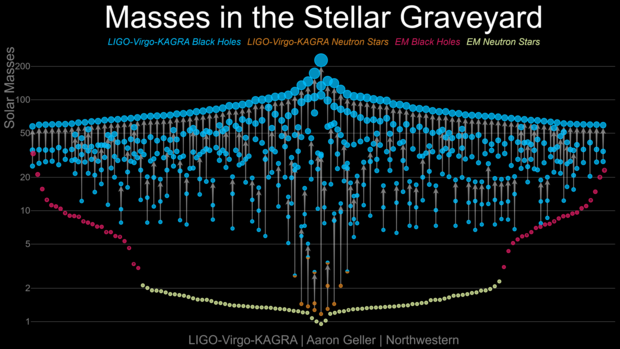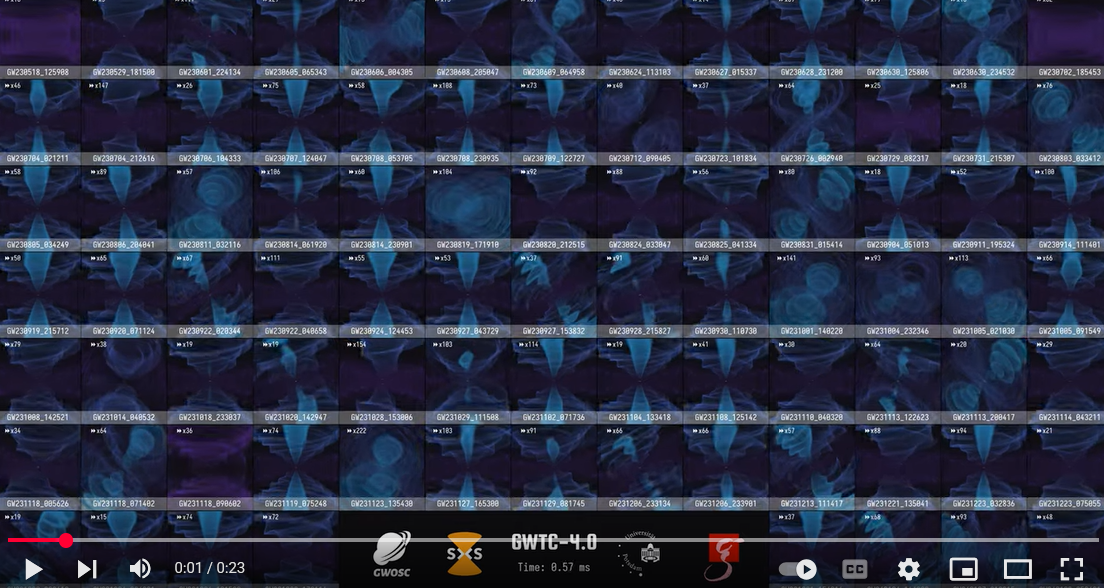
This newest version of the "Masses in the Stellar Graveyard" plot compares the numbers and masses of black holes and neutron stars discovered by the LVK (blue and orange dots) through January 2024, in just over eight years since the first detection, with those discovered by electromagnetic (EM) means (red and yellow dots) over the last ~60 years. The accelerated rate of discoveries by the LVK illustrates how effective gravitational wave detectors are at revealing a side of the universe that is virtually inaccessible to EM observers. [Credit: LIGO-Virgo-KAGRA / Aaron Geller / Northwestern]
GWTC-4.0: Updated Gravitational-Wave Catalog Released
News Release • August 26, 2025
August 26th 2025 marks an important date for the international LIGO, Virgo, and KAGRA (LVK) gravitational-wave network. The collaborations are releasing the interferometric strain data from the first part of the fourth observing run (O4a) that took place from May 24th, 2023, to January 16th, 2024. More detailed information about the data release can be found on the Gravitational Wave Open Science Center (GWOSC).
In addition to the data, the LVK is also releasing version 4.0 of the Gravitational Wave Transient Catalog (GWTC-4.0), which contains 128 new significant gravitational wave signal candidates. In the coming weeks, the LVK will also be sharing several companion papers to accompany the catalog, summarizing its implications for the broader fields of astrophysics and cosmology, testing Einstein’s theory of general relativity, and searching for signatures of gravitational lensing. These collected works are in the process of submission to the Astrophysical Journal Letters for eventual publication in a special-focus issue.
The GWTC-4.0 release includes several interesting candidates, such as the recently announced GW231123 – likely the highest-mass binary black hole merger observed to date. This latest release includes the primary output data from the interferometers, information enabling scientists to assess the quality of the data, and more detailed descriptions of the properties of the new signal candidates. Additionally, it includes a subset of data spanning May 15th – 19th, 2023 used in gravitational wave searches associated with supernova 2023ixf and the neutron star-black hole binary candidate GW230518_125908.

This animation compares computer simulations of 86 GW candidate detections released in GWTC4. Click on the image to view the video in YouTube, where you can also learn more about what it shows. Copyright I. Markin (Potsdam University), T. Dietrich (Potsdam University and Max Planck Institute for Gravitational Physics), H. Pfeiffer (Max Planck Institute for Gravitational Physics). Acknowledgements: Numerical relativity simulations of the black hole mergers provided by the Simulations of Extreme Spacetimes (SXS) waveform database. I. Markin and T. Dietrich gratefully acknowledge the support of Deutsche Forschungsgemeinschaft (DFG) through Project No. 504148597. This animation was rendered using the Rose gravitational-wave visualization toolkit and powered primarily by renewable energy.
This release marks the first in a sequence of planned public data releases from the LVK’s ongoing fourth observing run (O4), currently scheduled to continue through November 2025. In addition to data releases and journal publications, the collaboration also provides public alerts for gravitational wave event candidates in real-time via NASA’s General Coordinates Network (GCN). To date, the collaboration has published over 300 such alerts across its four observing runs. The LVK Collaboration will continue to share O4 results as they emerge, with each new discovery adding to our rapidly expanding understanding of the universe's most extreme events.
You can read more about this data release on our dedicated O4a catalog page
For a fun, interactive version of the Masses in the Stellar Graveyard plot, visit https://media.ligo.northwestern.edu/gallery/mass-plot








